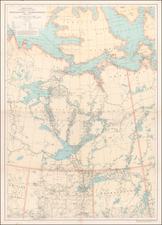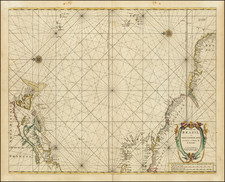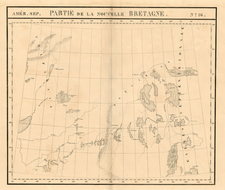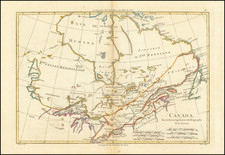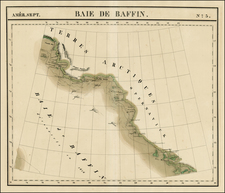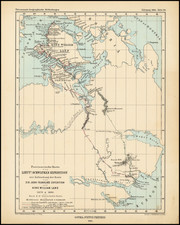Fine example of Gerard Hulst Van Keulen's sea chart of Eastern Canada, Newfoundland, etc., published in Amsterdam in 1783.
The map is highly detailed, relying in part on the information derved from Des Barres charts of the region, with a fantastic inset of Quebec. One interesting note, provided by Michael Buehler of Boston Rare Maps, helps to understand why the House of Van Keulen was no long pre-emininent in the American chart market by this time period:
T he title contains an error reflecting the firm's ignorance of how the British administration worked at the time the chart was made. Only the Newfoundland (Cook & Lane) and Nova Scotia (Des Barres) surveys were conducted under Admiralty orders. The rest, including Prince Edward Island, Cape Breton, and New England, were conducted by Samuel Holland working under orders of the Board of Trade.
Regarding the source of the chart, Ashley Baynton Williams notes on Mapforum as follows:
This rare sea-atlas is apparently a version of van Keulen's Eene Verzameling Van Nieuwe Zee-Kaarten Van Noord-America In Het Groot Beginnende Van Kaap Charles, Of De Golf Van St. Laurens, Tot Aan De Golf Van Mexico ...
Koeman records two examples of the sea-atlas with title-pages. The first, with the title dated 1785, is in the Nederlandsch Historisch Scheepvaartmuseum, Amsterdam. The second, with the title undated, is in the William L. Clements Library, University of Michigan.
The [atlas] was assembled for ship-board use . . . Also the maps [typically] printed on very thin paper and then pasted together in such a way that the right-hand side of the first chart backs onto the left-hand of the second, and so on. The two outer pages [were] then covered with the traditional protective blue-backing, associated with charts supplied for ship-board use, and then stored as a roll in a pigeon-hole.
The chart title continues as follows:
These Charts are followed, according to them Executed by order of the LORDS COMMISSIONERS of the ADMIRALTY in ENGLAND to be Sold at AMSTERDAM, by Gerard Hulst van Keulen Anno 1783.
In these Charts is to be found, Quebeck, as also the other Places Situated, on the Longitude, which is according to the Latest Observations of the English, and French Academy's but in the English Charts which are Executed by order of /he Admiralty, Quebeck and all other Places lay a bout 1 ½ Degree Westerley.
The Van Keulens were a family of chartmakers and publishers. The firm, In de Gekroonde Lootsman (In the Crowned Pilot), was founded in 1678 by Johannes van Keulen (1654-1715). Van Keulen originally registered his business as a vendor of books and instruments (specifically cross-staffs). In 1680, however, he gained a privilege from the States of Holland and West Friesland for the publication of pilot guides and sea atlases.
In that year, van Keulen released his Zee-Atlas (Sea Atlas), which secured him a name in the competitive maritime publishing market. In 1681, he published the first volume of Nieuwe Lichtende Zee-Fakkel (New Shining Sea Torch). This would be the first of an eventual five volumes originally published between 1680 and 1684. A sixth volume was added in 1753. The Zee-Fakel won van Keulen lasting fame. The atlas had charts compiled by Claes Jansz Vooght and artwork from Jan Luyken. It proved immensely popular and was reprinted until 1783. There were translations in French, English, Spanish, and Italian.
The late-seventeenth century was an auspicious time to enter the maritime chart business. Previous industry leaders had either closed shop, died, or retired, leaving space for a new competitor. Van Keulen proceeded to buy up the stock and privileges of several maritime publishing firms; the most notable was the stock of Hendrik Doncker, acquired in 1693.
Johannes’ son, Gerard (1678-1726) took over the business upon his father’s death. Gerard was a skilled engraver and mathematician. His talents were noticed, as in 1706 he was named as Hydrographer to the Dutch East India Company (VOC).
In turn, Gerard’s son Johannes II (1704-1770) came to run the shop. He was also tied to the VOC, and his role as their chartmaker allowed his charts to be considered as quasi-official government documents. It is with access to formerly clandestine VOC geographic knowledge that Johannes the Younger was able to add a sixth volume to the Zee-Fakkel, which covered the East Indies. Johannes also continued to sell instruments, including the recently-invented Hadley’s Quadrant from 1744.
When Johannes II died in 1770, his widow ran the business in his stead, aided by her two sons, Cornelis Buys (1736-1778) and Gerard Hulst (1733-1801). Now a century old, the family business had extended to include an anchor factory. After Cornelis died in 1778, Gerard took on the management of the firm alone. He oversaw the introduction of sextants to their inventory and published the Dutch Nautical Almanac beginning in 1788. Annual editions appeared until 1885. Gerard also served as an original member of the Dutch Commission for Longitude at Sea from 1787.
Gerard’s widow ran the business for nine years after his death, when their son, Johannes Hulst, started to lead the firm in 1810. After his death in 1844, the firm passed out of family hands and into the control of Jacob Swert, a skilled cartographer who had worked for the business for two decades. He passed the work to his son, another Jacob, in 1866. By the mid-nineteenth century, the conversion from sail to steam had diminished the size of the market for charts. Fewer sailors needed fewer maps, charts, and instruments. In 1885, after 207 years in business, In de Gekroonde Lootsman closed its doors and auctioned its stock.









